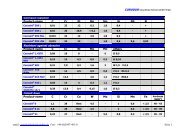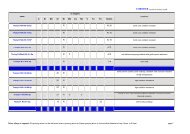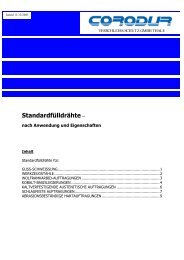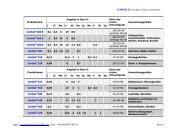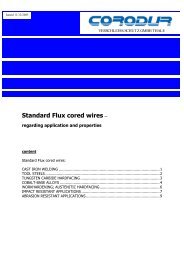Microstructure and properties of new developed Fe-Cr-C-B powders ...
Microstructure and properties of new developed Fe-Cr-C-B powders ...
Microstructure and properties of new developed Fe-Cr-C-B powders ...
You also want an ePaper? Increase the reach of your titles
YUMPU automatically turns print PDFs into web optimized ePapers that Google loves.
<strong>Microstructure</strong> <strong>and</strong> <strong>properties</strong> <strong>of</strong> <strong>new</strong> <strong>developed</strong> <strong>Fe</strong>-<strong>Cr</strong>-C-B <strong>powders</strong> for wearprotection<br />
purposes<br />
Abstract<br />
In wear protection <strong>of</strong> machinery parts from cement-, mining-,<br />
metallurgy <strong>and</strong> agriculture industry it is state-<strong>of</strong>-art to apply<br />
durable <strong>and</strong> cheap coatings with alloys from the system <strong>Fe</strong>-<strong>Cr</strong>-<br />
C-B. Since these parts are <strong>of</strong>ten exposed to extreme abrasive<br />
wear there is a need for thick coatings which are usually<br />
produced with cored wires. These wires can also be designed<br />
for the use in arc-spraying or flame spraying process to<br />
produce coatings within the range from 0.2 mm to some mm.<br />
However the characteristic <strong>of</strong> both processes is not suitable for<br />
all technical requirements which <strong>of</strong>ten need more dense<br />
coatings with higher bond strength. In this article the research<br />
on <strong>new</strong>, completely alloyed <strong>Fe</strong>-<strong>Cr</strong>-C-B <strong>powders</strong> which can be<br />
applied with HVOF spraying techniques is presented. To<br />
achieve high wear protection the content <strong>of</strong> chromium lies in<br />
the range <strong>of</strong> 30weight% <strong>and</strong> carbon content is about 5weight%<br />
which causes a unique powder structure <strong>and</strong> coatings with a<br />
homogeneous high carbide content. The <strong>powders</strong> <strong>and</strong> coatings<br />
are examined by metallographic analysis including SEM<br />
microscopy. The tested wear behavior is presented <strong>and</strong><br />
underlines the use <strong>of</strong> this material for several wear protection<br />
purposes. Moreover it is discussed how far these completely<br />
alloyed <strong>powders</strong> can partially substitute conventional carbide<br />
coatings.<br />
Introduction<br />
Machine parts <strong>and</strong> units are faced to different stresses. Wear -<br />
which usually starts on the surfaces – gobbles up enormous<br />
amounts <strong>of</strong> money in every national economy. Therefore<br />
many processes <strong>and</strong> strategies for protecting surfaces or<br />
repairing worn out parts have been <strong>developed</strong>. Thermal<br />
spraying processes play an increasing important role <strong>and</strong> still<br />
show a high developing potential (Ref 1).<br />
This is due to a wide range <strong>of</strong> optimized processes which are<br />
applicable to tasks from the electronic industry requiring thin<br />
functional coatings up to thick coatings for the ventilator<br />
industry. Besides the processes the spraying materials are <strong>of</strong> a<br />
big interest in research <strong>and</strong> development. Regarding anti-wear<br />
coatings one can see various tendencies in material<br />
development for thermal spraying. Against the background <strong>of</strong><br />
achieving longer life time <strong>of</strong> machine parts <strong>and</strong> units the<br />
optimization <strong>of</strong> material compositions for different<br />
applications is a big point. An <strong>of</strong>ten quoted example is the<br />
replacement <strong>of</strong> hard chrome (Ref 2). However for remaining<br />
competitive against other technologies <strong>and</strong> moreover for<br />
A. Pelz<br />
Corodur Verschleiss-Schutz GmbH, Thale<br />
*E-mail: pelz@verschleissschutz-thale.de<br />
conquering <strong>new</strong> markets there is also a need to develop <strong>new</strong><br />
spraying materials which are a) better in their <strong>properties</strong> or b)<br />
lower in their costs with almost same <strong>properties</strong> during<br />
application. Latter is <strong>of</strong>ten described in literature with the<br />
attempt to substitute expensive Ni,- Co- or WC coatings with<br />
iron base materials (Ref 3, 4) .<br />
The intension <strong>of</strong> this paper is to show the <strong>properties</strong> <strong>of</strong> <strong>new</strong><br />
<strong>developed</strong> <strong>Fe</strong>-<strong>Cr</strong>-C-B <strong>powders</strong> in comparison with two<br />
conventional carbide coatings. The <strong>new</strong> <strong>developed</strong> iron-base<br />
<strong>powders</strong> are produced via melt atomization <strong>and</strong> therefore<br />
completely alloyed.<br />
Experimental<br />
Powder feedstock<br />
Three different kinds <strong>of</strong> <strong>powders</strong> were produced via melt<br />
atomization. The chemical composition (Table 1) is similar to<br />
established cored-wires <strong>of</strong> the type Corthal® from Corodur<br />
Verschleiss-Schutz GmbH which serve as hardfacings against<br />
abrasive wear. These wires can be processed by open-arc<br />
welding. The manufactured <strong>powders</strong> were screened to a grain<br />
size <strong>of</strong> 20-45µm. As comparison two commercial carbide<br />
<strong>powders</strong> were utilized. A tungsten carbide based powder from<br />
type WC/Co 88/12 was supplied from Sulzer Metco with the<br />
product name Woka 3102 (15-45µm). The other utilized<br />
carbide powder 25Ni<strong>Cr</strong>-75<strong>Cr</strong>C is commercially available<br />
under the name Woka 7202 (15-45µm).<br />
Table 1 Chemical composition <strong>of</strong> tested <strong>powders</strong> in weight<br />
percent<br />
C Si Mn <strong>Cr</strong> B Nb<br />
Powder 1 4.7 2.3 0.2 28.9 - -<br />
Powder 2 5.2 2.0 0.3 30.0 0.5<br />
Powder 3 4.2 2.0 0.2 26 - 2.2<br />
HVOF Thermal spraying process<br />
The coatings were produced using the Sulzer Metco Diamond<br />
Jet spraying gun DJCE with propane as fuel. The <strong>powders</strong><br />
were volumetric-controlled fed with the commercial powder<br />
feeder TWIN 120-E. Every powder was sprayed with the same<br />
parameters (Table 2). Approximately 0.3 mm thick coatings<br />
were produced without the use <strong>of</strong> a bond coating.
Table 2 Spraying parameters using the Sulzer Metco DJCE<br />
spraying gun<br />
O2 C3H8 Air Overrun distance<br />
267 57 329 30 m/min 275 mm<br />
slpm slpm slpm<br />
Metallography<br />
The <strong>powders</strong> <strong>and</strong> coatings were analyzed by means <strong>of</strong><br />
conventional light microscopy. For higher resolutions (>500<br />
times) SEM microscopy with attached EDX was used. For<br />
reliable analyses <strong>of</strong> appearing phases within the <strong>powders</strong> <strong>and</strong><br />
coatings X-ray fluorescence analysis was carried out on<br />
<strong>powders</strong> <strong>and</strong> coatings <strong>of</strong> powder 2. The visible microstructure<br />
on the presented pictures was <strong>developed</strong> using the etching<br />
agent “VA-Beize”. As embedding agent for the <strong>powders</strong> a<br />
combination <strong>of</strong> copper powder <strong>and</strong> hardener was used.<br />
Therefore red shinning small particles can be seen in the<br />
microsections <strong>of</strong> the <strong>powders</strong> which represent the copper<br />
particles (“X” in Figs. 1 <strong>and</strong> 4).<br />
Wear Tests<br />
The wear tests were carried out using a Harworth – ZIS –<br />
testing device. The coated specimens with the dimension 20 x<br />
20 mm² are pressed against a rotating wheel. This equipment<br />
makes it possible to test under 2-body- <strong>and</strong> 3-body-abrasiv<br />
wear conditions. While the 3-body-abrasiv wear test is done<br />
with a Hardox 500 steel-wheel a rubber wheel is used to test<br />
under 2-body-abrasive wear conditions. Both tests were using<br />
dry s<strong>and</strong> as abrasive with an available grain size <strong>of</strong> 0.1 – 0.3<br />
mm. In order to measure only the influence <strong>of</strong> the coatings the<br />
force pressing the specimens on the rotating wheel was set on<br />
30 N. The wear is determined by the weight loss <strong>and</strong> presented<br />
as wear intensity (by relating the weight loss to the wear<br />
distance).<br />
Results<br />
Powder <strong>Fe</strong>edstock<br />
The microsection in Fig. 1 shows the powder 2. The<br />
morphology <strong>of</strong> the <strong>powders</strong> ranges from tear drop like to<br />
spherical. One can see that the powder particles show a<br />
uniform microstructure with more or less white phases<br />
surrounded by a grayish-black matrix. The appearance <strong>of</strong> the<br />
white phases is similar to that <strong>of</strong> iron-chromium-carbides<br />
known from hardfacings. Depending on the section plane<br />
these carbides can be seen as needles or as hexagons.<br />
Table 3 Hardness <strong>of</strong> different carbides (Ref 5, 6, 7)<br />
*HV0.05<br />
hard-<br />
ness<br />
[HV]<br />
VC WC TiC <strong>Cr</strong>7C3 (<strong>Fe</strong>-<br />
2940 2350 3200 2200<br />
<strong>Cr</strong>)7C3<br />
1300<br />
–<br />
1600*<br />
Mo2C NbC<br />
1660 1800<br />
It has been the intention <strong>of</strong> this work to produce powder<br />
particles build up <strong>of</strong> carbides with chromium as main alloying<br />
element. These carbides are not the hardest known carbides<br />
however one <strong>of</strong> the most effective. The achieved hardness<br />
(Table 3) is sufficient that many minerals can’t scratch them<br />
<strong>and</strong> the formulation <strong>of</strong> chromium-carbides is relatively cheap<br />
requiring chromium <strong>and</strong> carbon as alloying elements.<br />
Moreover iron can be used as base material. For the wear<br />
behavior pure chromium carbides are preferred since the<br />
formation <strong>of</strong> iron-chromium-carbides reduces the carbide<br />
hardness.<br />
Figure 1: microsection <strong>of</strong> powder 2, 500x<br />
The XRF-analysis in Fig. 2 proved that there are pure<br />
chromium-carbides in the microstructure <strong>of</strong> powder 2 (“A”,<br />
“C”, “D” in Fig. 2). It was actually expected to find iron-<br />
300<br />
)<br />
ts<br />
n200 u<br />
o<br />
(C<br />
in<br />
L<br />
100<br />
0<br />
A<br />
4.2a D - <strong>Fe</strong>-Basis-Pulver (n. WB)<br />
C<br />
B<br />
15 20 30 40 50 60 70 80 90 100 110 120 130<br />
2-Theta - Scale<br />
Pulver - File: 460010_4_2a.RAW - Type: 2Th/Th locked - Start: 15.000 ° - End: 135.000 ° - Step: 0.050 ° - Step time: 5. s - Temp.: 25 °C (Room) - Time Started: 6 s - 2-Theta: 15.000 ° - Theta: 7.500 ° - Phi: 0.00 ° -<br />
Operations: Import<br />
06-0696 (*) - Iron, syn - <strong>Fe</strong> - Y: 50.00 % - d x by: 1. - WL: 1.78897 - Cubic - a 2.86640 - b 2.86640 - c 2.86640 - alpha 90.000 - beta 90.000 - gamma 90.000 - Body-centred - Im-3m (229) - 2 - 23.5511 -<br />
06-0683 (D) - Carbon Chromium - <strong>Cr</strong>7C3 - Y: 50.00 % - d x by: 1. - WL: 1.78897 -<br />
17-0333 (I) - Iron Carbide - <strong>Fe</strong>7C3 - Y: 50.00 % - d x by: 1. - WL: 1.78897 - Hexagonal - a 6.88200 - b 6.88200 - c 4.54000 - alpha 90.000 - beta 90.000 - gamma 120.000 - Primitive - P63mc (186) - 2 - 186.215 -<br />
78-1502 (C) - Chromium Iron Carbide - <strong>Cr</strong>15.58<strong>Fe</strong>7.42C6 - Y: 50.00 % - d x by: 1. - WL: 1.78897 - Cubic - a 10.59900 - b 10.59900 - c 10.59900 - alpha 90.000 - beta 90.000 - gamma 90.000 - Face-centred - Fm-3<br />
Figure 2: XRF analysis <strong>of</strong> powder2<br />
chromium-carbides instead <strong>of</strong> pure chromium carbides.<br />
Therefore different mixed carbides were checked whether they<br />
suit to the analysis. The pink triangles represent the most<br />
probable ones. However there is no real peak nearby.<br />
E<br />
X<br />
F
Therefore it is very likely that no important amounts <strong>of</strong> ironchromium-carbides<br />
exist besides pure chromium carbides. A<br />
main peak (“A”) between 52° <strong>and</strong> 53° belongs to body<br />
centered iron which is slightly adjusted (“E”,”F”) with higher<br />
2-theta-angles. Moreover the double peak at 46° <strong>and</strong> 47° (“B”)<br />
suggests that the microstructure contains <strong>Fe</strong>7C3. Unfortunately<br />
it wasn’t possible to detect to which phase the low amounts <strong>of</strong><br />
boron are linked with.<br />
Figure 3: SEM picture <strong>of</strong> powder3, 500 x<br />
Figure 3 <strong>and</strong> Figure 4 show the morphology <strong>and</strong><br />
microstructure <strong>of</strong> powder 3. The addition <strong>of</strong> niobium seemed<br />
to have an influence on the viscosity <strong>of</strong> the melt since the<br />
droplets are not looking as spherical as seen for the <strong>powders</strong> 1<br />
<strong>and</strong> 2. The comparison <strong>of</strong> Fig. 1 <strong>and</strong> Fig. 4 indicates a<br />
different microstructure for powder 3. Some particles don’t<br />
seem to react during etching <strong>and</strong> remain in a<br />
4<br />
2<br />
Figure 4: microstructure <strong>of</strong> powder 3, 500x<br />
3<br />
X<br />
1<br />
grayish color without any structure (“1” in Fig. 4). Other<br />
particles show the typical (iron-) chromium-carbides but not<br />
as densely packed <strong>and</strong> not as big grown (“2” in Fig. 4) within<br />
each particle as it can be seen in Fig. 1 for powder 2. Within<br />
two particles two grayish particles seem to be incorporated<br />
(“3” in Fig. 4). On the bottom <strong>of</strong> the Fig. 4 are two particles<br />
with merging structures (“4” in Fig. 4).<br />
The two different microstructures can be explained by the<br />
addition <strong>of</strong> niobium which has a higher affinity to carbon than<br />
chromium. Due to this property MC (M: mainly Nb) dissolves<br />
some amounts <strong>of</strong> carbon first with the result that there is less<br />
carbon available for chromium. Therefore the iron-chromiumcarbides<br />
are less densely packed <strong>and</strong> when the amount <strong>of</strong><br />
available free carbon drops – even locally – under the<br />
hypereutectic amount no primary carbides will be formed.<br />
Against the background <strong>of</strong> this effect the chemical<br />
composition <strong>of</strong> the powder 3 should be designed again.<br />
Obviously the carbon content is not sufficient. The assumption<br />
that the incorporated grayish particles are niobium carbide<br />
particles will be later analyzed on the coatings.<br />
Coatings<br />
The <strong>powders</strong> were sprayed with the st<strong>and</strong>ard parameters<br />
without any problems during feeding. Although there was no<br />
bonding material sprayed before coating with the hard alloys<br />
the coatings show a good bonding to the substrate. The<br />
difference between the <strong>powders</strong> 1 <strong>and</strong> 2 is small <strong>and</strong> so the<br />
spraying results are almost similar. Figure 5 shows the coating<br />
produced with powder 1. The porosity could be kept low (< 5<br />
%) even with the not optimized st<strong>and</strong>ard spraying parameters.<br />
Figure 5: LM picture <strong>of</strong> sprayed coating made <strong>of</strong> powder 1,<br />
63x<br />
The coating is build up <strong>of</strong> molten <strong>and</strong> not completely molten<br />
particles. The completely molten particles are not so easy to<br />
etch. That difference could not be observed for the powder.<br />
However, with higher magnification (Fig. 6) it is visible that
even these brighter areas have uniformly distributed ironchromium-carbides<br />
in their microstructures.<br />
Figure 6: microsection <strong>of</strong> coatings <strong>of</strong> powder 2, 500x<br />
This is underlined by the XRF-analyses presented in Fig. 7<br />
since no <strong>new</strong> phases appear. It still contains the main peak<br />
(“D” in Fig. 7) for body centered iron <strong>and</strong> a second phase<br />
which is identified as pure chromium carbide (blue lines or<br />
“A”, “C”, “D” in Fig. 7). In contrast to the powder (Fig. 2) the<br />
phases <strong>Fe</strong>7C3 <strong>and</strong> the iron-chromium-carbide couldn’t be<br />
related to the XRF-analysis <strong>of</strong> the sprayed coating. Since both<br />
phases were not definitely a component in the powder it is as<br />
well not so definite to explain the existing difference between<br />
powder <strong>and</strong> coating. Regarding the Fig. 7 one can see that<br />
there is no visible peak like “B” in Fig. 2 which could be<br />
related to any different phase. However the base area (“G” in<br />
Fig. 7) around the main peak is much higher curved than the<br />
analysis <strong>of</strong> the powder. This effect can be explained either<br />
with several phases which are contained in low amounts or<br />
with phase(s) whose size lies under the resolution <strong>of</strong> the XRF<br />
analysis.<br />
Lin (Counts)<br />
500<br />
400<br />
300<br />
200<br />
100<br />
0<br />
4.2b - <strong>Fe</strong>-Basis-Spritzschicht D<br />
(n. WB)<br />
C<br />
A<br />
15 20 30 40 50 60 70 80 90 100 110<br />
Spritzschicht auf Kompaktprobe - File: 460010_4_2b.RAW - Type: 2Th/Th locked - Start: 15.000 ° - End: 135.000 ° - Step: 0.050 ° - Step time: 10. s - Temp.: 25 °C (Room) - Time Started: 5 s - 2-Theta: 15.000 ° - T<br />
Operations: Import<br />
06-0696 (*) - Iron, syn - <strong>Fe</strong> - Y: 50.00 % - d x by: 1. - WL: 1.78897 - Cubic - a 2.86640 - b 2.86640 - c 2.86640 - alpha 90.000 - beta 90.000 - gamma 90.000 - Body-centred - Im-3m (229) - 2 - 23.5511 -<br />
06-0683 (D) - Carbon Chromium - <strong>Cr</strong>7C3 - Y: 50.00 % - d x by: 1. - WL: 1.78897 -<br />
Figure 7: XRF analysis <strong>of</strong> coating made <strong>of</strong> powder 2<br />
G<br />
2-Theta - Scale<br />
Figure 8 : XRF analysis <strong>of</strong> coating made <strong>of</strong> powder 3<br />
The coatings made from powder 3 show a higher porosity <strong>and</strong><br />
an inferior bonding quality between the particles (Figure 8)<br />
compared with the coatings from powder 1 <strong>and</strong> 2. In Fig. 9<br />
one can also see that the incorporated particles <strong>of</strong> which it was<br />
assumed that they are niobium carbides are still present in the<br />
microstructure <strong>of</strong> the sprayed coating. The quantitative<br />
analysis (Table 4) proved that these phases (area 1) are rich in<br />
niobium <strong>and</strong> carbon in the typical composition <strong>of</strong> carbides<br />
from the structure MC. The other areas (2-4) are a mixture <strong>of</strong><br />
elements containing high amounts <strong>of</strong> iron with different<br />
amounts <strong>of</strong> chromium <strong>and</strong> carbon. In the phase 4 small<br />
structures remind on the (iron-) chromium-carbides. The EDX<br />
analysis in this area results in higher amounts <strong>of</strong> chromium<br />
<strong>and</strong> carbon as seen for the areas 2 <strong>and</strong> 3.<br />
3<br />
1<br />
Figure 9: SEM detail <strong>of</strong> coating made <strong>of</strong> powder 3, 4000x<br />
Figure 9 also shows that there is a disbonding between the not<br />
completely molten particles <strong>and</strong> following splats. This can<br />
result in cracking under load or easier loose <strong>of</strong> particles under<br />
abrasive attack. In the center <strong>of</strong> the 3 niobium carbides a<br />
4<br />
2
whole is visible. This could be a disadvantage under load, too.<br />
It seems as if the whole results from the deformation during<br />
impact <strong>of</strong> the particle.<br />
Table 4 EDX analysis <strong>of</strong> selected areas from the Fig. 9 in the<br />
coating produced with the powder 3<br />
1 2 3 4<br />
Weight % <strong>Fe</strong> 1 60 70 51.7<br />
Weight % Nb 77.6 5.9 2,5 2.4<br />
Weight % <strong>Cr</strong> 0.4 25 19.3 34.4<br />
Weight % Si - 1.5 2.0 0.9<br />
Weight % C 21 7.6 6.2 10.6<br />
Microhardness<br />
From Fig. 10 one can see that from the three <strong>new</strong> <strong>developed</strong><br />
<strong>powders</strong> the powder 2 achieves the highest values. With an<br />
average value <strong>of</strong> 957 HV0.1 they are very close to<br />
measurements for the Ni<strong>Cr</strong>-<strong>Cr</strong>C powder with an average value<br />
<strong>of</strong> 1002 HV0.1. The highest microhardness was observed for<br />
the coatings made <strong>of</strong> WC/Co powder. This can be explained<br />
with the higher hardness <strong>of</strong> the contained tungsten carbides<br />
compared to the (iron)-chromium-carbides as it can be seen<br />
from Table 3. However, one should consider that the size <strong>of</strong><br />
the carbide particles WC <strong>and</strong> <strong>Cr</strong>C is bigger than the primary<br />
chromium carbides are but still smaller than the microhardness<br />
indentation (HV 0.1). Thus the given microhardness values<br />
represent a mixture <strong>of</strong> values for the hard phase <strong>and</strong> the<br />
matrix.<br />
While the microhardness <strong>of</strong> powder 1 is about 783 HV0.1 <strong>and</strong><br />
about 845 HV0.1 for powder 3 the average value for powder 2<br />
is about 100-170 HV0.1 higher. The chemical composition<br />
seen in Table 1 can give an explanation. The powder 2 has the<br />
highest carbon content <strong>and</strong> an amount <strong>of</strong> 0.5 weight percent<br />
boron. Both elements form hard phases what can support the<br />
hardness or rather increase the amount <strong>of</strong> hard phases.<br />
Figure 10: microhardness <strong>of</strong> the sprayed coatings in HV0.1<br />
Wear tests<br />
In the 2-body wear test (Fig. 11) the coatings produced with<br />
the <strong>new</strong> <strong>developed</strong> <strong>powders</strong> show a better wear intensity<br />
compared to the two conventional carbide <strong>powders</strong>. The best<br />
results were achieved with the powder 2 while the powder 1 is<br />
only slightly inferior. In this testing method the carbide<br />
coatings produced with the powder from the type WC/ Co<br />
shows the worst results with 56% higher weight loss compared<br />
to powder 2. From the group <strong>of</strong> the <strong>new</strong> <strong>developed</strong> <strong>powders</strong><br />
leads the powder 3 to the highest wear intensity which is about<br />
35 % higher than for powder 2.<br />
The results for the 3-body wear test look different. The wear<br />
intensity for the coatings sprayed with the <strong>powders</strong> 1, 2 <strong>and</strong><br />
Ni<strong>Cr</strong>-<strong>Cr</strong>C have almost the same values around 500 mg/km. In<br />
this testing method the WC/ Co coatings show the best results.<br />
The wear intensity <strong>of</strong> 367 mg/km is 36 % better compared to<br />
the second best coating produced with the <strong>new</strong> <strong>developed</strong><br />
powder 2. In Fig. 12 one can also see that coatings produced<br />
with powder 3 result in coatings with the worst wear intensity.<br />
The value <strong>of</strong> 589 mg/km is about 18 % higher compared to<br />
powder 2.<br />
Figure 11: results from the 2-body wear test<br />
Figure 12: results from the 3-body wear test
Summary<br />
The aim <strong>of</strong> the work was to produce iron-base <strong>powders</strong> with<br />
embedded primary hard phases. In the first stage simple<br />
alloyed <strong>powders</strong> were designed in order to test very price<br />
attractive <strong>powders</strong> for wear protection purposes. Therefore<br />
two melt atomized <strong>powders</strong> were chosen from the system <strong>Fe</strong>-<br />
<strong>Cr</strong>-C with one powder also having boron as alloying element.<br />
Another powder was atomized which had niobium as<br />
additional alloying element in order to form fine distributed<br />
niobium carbides.<br />
Via XRF analysis chromium carbide <strong>Cr</strong>7C3 was identified as<br />
main primary hard phase. The metallographic examinations<br />
showed that these phases are very fine distributed in the<br />
<strong>powders</strong> <strong>and</strong> coatings.<br />
The actual idea to increase the wear resistance with the<br />
addition <strong>of</strong> niobium was not successful yet. However the<br />
results <strong>of</strong> the alloys from the system <strong>Fe</strong>-<strong>Cr</strong>-C-B (powder 2)<br />
showed excellent results in the wear tests. Tested against a<br />
rubber wheel <strong>and</strong> dry s<strong>and</strong> as abrasive (2-body wear test) the<br />
coatings produced with the powder 2 gave the best wear<br />
results – even compared to the conventional carbide coatings<br />
WC/Co <strong>and</strong> Ni<strong>Cr</strong>-<strong>Cr</strong>C.<br />
Switching from a 2-body to 3-body wear test by replacing the<br />
rubber wheel against a steel wheel (Hardox 500) the wear <strong>of</strong><br />
the tested coatings changes, too. Under that condition the<br />
WC/Co coatings give the best results followed by the coatings<br />
from the system <strong>Fe</strong>-<strong>Cr</strong>-C-B (powder 2).<br />
It is clear that for good wear protection the analysis <strong>of</strong> the<br />
tribological system is necessary. For several industrial<br />
applications a coating consisting <strong>of</strong> hard particles embedded in<br />
a s<strong>of</strong>t matrix is not the best solution. The carried out wear tests<br />
confirm this comment. Since the hard materials can be simply<br />
washed out <strong>of</strong> the matrix it is sometimes better to choose a<br />
material with a microstructure consisting <strong>of</strong> fine distributed<br />
hard phases. Therefore the <strong>new</strong> <strong>developed</strong> completely alloyed<br />
<strong>powders</strong> from the system <strong>Fe</strong>-<strong>Cr</strong>-C-B with primary hard phases<br />
can be used to close a gap for the wear protection which<br />
consists between conventional carbide <strong>powders</strong> <strong>and</strong> low<br />
alloyed steel <strong>powders</strong>.<br />
References<br />
1. DVS-Berichte B<strong>and</strong> 245, Thermisches Spritzen –<br />
Potentiale, Entwicklungen, Märkte; ISBN 978-3-87155-<br />
251-9<br />
2. C. Wassermann, J. Bürmann, S. Gustafsson <strong>and</strong> R.<br />
Böcking, “Replacement <strong>of</strong> Chrome Platings by HVOF-<br />
Coatings”, Kolloquium Hochgeschwindigkeits-<br />
Flammspritzen, 2000, p. 109-114<br />
3. T. Azarova, P. Vityaz, B. Wielage, S. Steinhäuser <strong>and</strong> H.<br />
Podlesak, “Coherence between structure <strong>and</strong> <strong>properties</strong> <strong>of</strong><br />
TiC containing thermal spraying”, Proceedings ITSC<br />
2002, Essen, p. 96-101<br />
4. B. Wielage et al., "HVOF sprayed high chromium <strong>and</strong><br />
<strong>and</strong> high vanadium containing iron based hard coatings for<br />
combined abrasive wear <strong>and</strong> corrosion protection”,<br />
Proceedings ITSC 2005, Basel, p. 887-891<br />
5. A. Gebert, „Entwicklung vanadinhaltiger<br />
Schweißzusatzwerkst<strong>of</strong>fe auf Nickelbasis zum Schutz<br />
gegen Verschleiß und Korrosion“, AiF-Abschlussbericht<br />
12.754 BG, 2003<br />
6. W. Theißen, R. Winkelmann, A. Pelz, B. Reichmann,<br />
„Auftragschweißen von Wolframkarbid in <strong>Fe</strong>-Basis-<br />
Legierungen“, 7. Fachtagung Verschleißschutz von<br />
Bauteilen durch Auftragschweißen, 2008, p 65-70<br />
7 H. Uetz, „Abrasion und Erosion“, Carl Hanser Verlag<br />
München Wien, 1986, ISBN 3-446-14215-0, p.54



